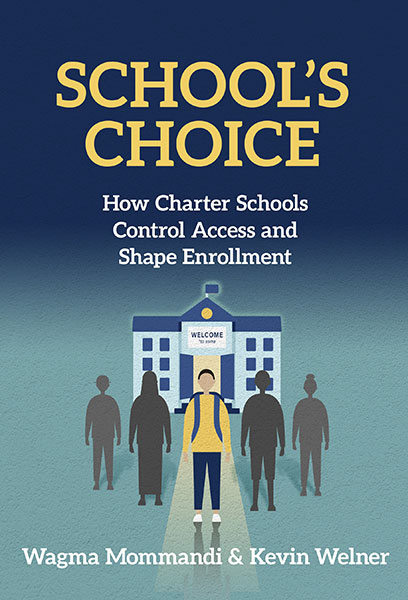Professors: Request an Exam Copy
Print copies available for US orders only. For orders outside the US, see our international distributors.
Publication Date: September 10, 2021
Pages: 232

Access issues are pivotal to almost all charter school tensions and debates. How well are these schools performing? Are they segregating and stratifying? Are they public and democratic? Are they fairly funded? Can apparent successes be scaled up? Answers to all these core questions hinge on how access to charter schools is shaped. This book describes the incentives and pressures on charter schools to restrict access and examines how charters navigate those pressures, explaining access-restricting practices in relation to the ecosystem within which charter schools are created. It also explains how charters have sometimes responded by resisting the pressures and sometimes by surrendering to them. The text presents analyses of 13 different types of practices around access, each of which shapes the school’s enrollment. The authors conclude by offering recommendations for how states and authorizers can address access-related inequities that arise in the charter sector. School’s Choice provides timely information on critical academic and policy issues that will come into play as charter school policy continues to evolve.
Book Features:
Wagma Mommandi, a former public-school teacher, is a PhD candidate in education policy at the University of Colorado Boulder School of Education. Kevin Welner is a professor and the director of the National Education Policy Center, which is housed at the CU Boulder School of Education.
“This compact but thorough book makes it clear that for many students, a charter school system provides no choice at all. It is the charter school that does the choosing, not the students or parents.”
—Forbes
“Mommandi and Welner deepen our understanding of familiar but rarely challenged contradictions that charter schools impose on our public education system. Vivid and well-researched accounts of practices limiting the neediest children’s access to charters expose far more than ‘bad actors’ (i.e., rule violators). Disparities in access, instead, are the logical consequence of state charter school policies. The authors brilliantly show these policy-sanctioned limits are solidly grounded in larger cultural norms and politics of market incentives, opportunity hoarding, and effectively maintaining inequality—the powerful forces that undermine the very democracy and equity that public schools struggle to make real.”
—Jeannie Oakes, Presidential Professor Emeritus, University of California, Los Angeles
“This book breaks new ground by focusing specifically on access to inform the public and the field. It’s a must-read, an accessibly written primer of charter school information. It is an ideal volume not only for academics and policymakers, but also for parents and communities to scrutinize the charter school ethos of equity and access.”
—Julian Vasquez Heilig, dean and professor, University of Kentucky
“The charter school experiment created thousands of new schools by giving public money to private groups. A spigot of billions has attracted geniuses and scoundrels but produced basically mediocre schools. They have become a political force and engage in many strategies to avoid supervision and control their enrollments through tactics that are skillfully dissected in this careful analysis. Like many private businesses, charter schools try to shape and manipulate their images and markets in a very complex pattern. This book untangles that pattern. An invaluable part describes efforts for diversity in this very segregated sector, equity policies, and accountability approaches that could be the key to getting a better return on a large and disappointing investment.”
—Gary Orfield, Distinguished Research Professor, University of California, Los Angeles
Contents
1. Introduction 1
The Issue of Access 3
A Framework for Understanding Access 5
Methods 8
Conclusion 12
2. The Centrality of Access 14
Publicness 14
Funding and Finance 16
Segregation and Stratification 17
Measured Outcomes 17
3. Description and Design: Which Niche? 20
Background Briefing 20
Further Research 21
Conclusion 29
4. Location, Location, Location: Decisions About Site and Transportation 30
Background Briefing 30
Further Research 31
Conclusion 36
5. Narrow-Casting: The Power of Marketing and Advertising 37
Background Briefing 37
Further Research 39
Conclusion 44
6. Hoop Schemes: Conditions Placed on Applications 45
Background Briefing 45
Further Research 47
Conclusion 55
7. The Steering Wheel: The Art of Dissuading Applications 56
Background Briefing 56
Further Research 58
Conclusion 61
8. Send Us Your Best: Conditions Placed on Enrollment 63
Background Briefing 63
Further Research 64
Conclusion 71
9. Putting in the Hours: Requiring Parents to Volunteer 72
Background Briefing 72
Further Research 74
Conclusion 77
10. Not in Service: Emergent Bilinguals, Special Education, and Free and Reduced-Price Lunch 78
Background Briefing 78
Further Research 80
Conclusion 88
11. The Fitness Test: Counseling Out 89
Background Briefing 89
Further Research 91
Conclusion 98
12. Pass Interference: GPAs and Grade Retention 99
Background Briefing 99
Further Research 100
Conclusion 105
13. No Excuses: Discipline and Punish 106
Background Briefing 106
Further Research 107
Conclusion 120
14. Irreplaceable: Backfilling Student Attrition 122
Background Briefing 123
Further Research 123
Conclusion 127
15. Show Me the Money: The Price of Attendance 129
Background Briefing 129
Further Research 130
Conclusion 137
16. Understanding Access 138
Competitive Incentives for Schools to Be Choosers 138
Opportunity Hoarding: Parents as Choosers 141
Effectively Maintained Inequality 144
17. Pursuing Equity Against the Tide 148
Attempts to Address Access Hurdles 148
The Rules and Incentives Must Change 155
18. Looking Ahead: Designing a Healthier System 158
Changing Incentives 159
Changing Rules 160
The Importance of Collecting and Reporting Data 169
Holding Authorizers Accountable 170
Conclusion 171
Notes 173
References 175
Index 213
About the Authors 225
Professors: Request an Exam Copy
Print copies available for US orders only. For orders outside the US, see our international distributors.